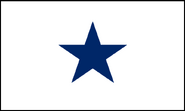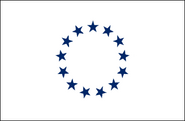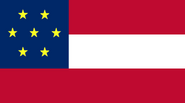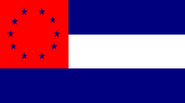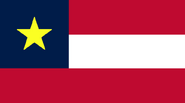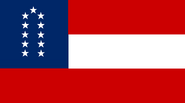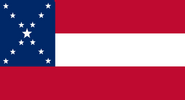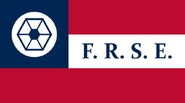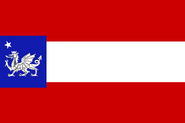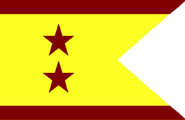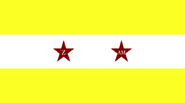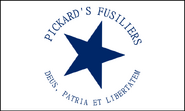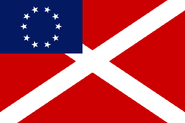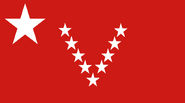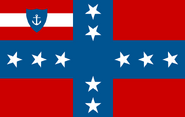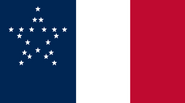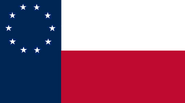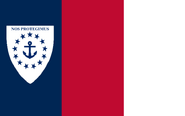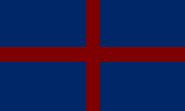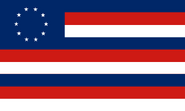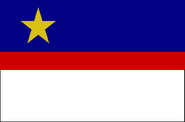| Canon
|
Any user is allowed to reference the contents of this article in their work.
Although the addition, removal, or alteration of the content requires the permission of the author, the author allows any user to reference this article's content in their work. Check the talk page for any conditions the author has attached.
Background and history[]
We, the people of the Confederate States of Earth, each State acting in her free and independent manner, in order to form a permanent and free Confederated government, establish justice, insure domestic tranquillity, and secure the blessings of liberty to ourselves and our posterity, invoking the favour and guidance of Almighty God, do ordain and establish this Constitution for the Confederate States of Earth.
—The Preamble of the Constitution of the Confederate States of Earth
The Confederate States of Earth, commonly known simply as the Confederacy, as well as the Confederate States, the CSE, the C.S. of Earth, the Confederation, the Confeds, the Separatists, the Rebel States, the Rebels, the Western Confederation, the Western States, the West, the Nationalist States, the Nationalists, the Conservatives, the Traditionalist States, Jane Zarkan's Confederation, Mother Confederacy, the Motherland, the Land of the White Dragon, and very rarely as the Second League of Independent Nations, referencing the proposed independent Traditionalist bloc during the Tariff Crisis of 37 BBY, sometimes as the Empire of the West by the Imperialists, as well as the Traitors, the Land of Treason, Jane Zarkan's Empire and the Traitor States by the Unionists) was an alliance of Right-wing Traditionalist, Nationalist, and Conservative CIS-allied nations on the planet Earth that were collectively a member of the Confederacy of Independent Systems, it was formed in 21 BBY by Jane Zarkan and other pro-CIS Earth leaders, the C.S.E signed an alliance with CIS.
The Confederacy was the ultimate outcome of decades of independence movements by the nations of Western Aeropica, the Confederacy's heritage could be traced as far back as the West Aerman Confederation of 237 BBY.
In 237 BBY the Zarkan Kingdom's centuries of building alliances with her fellow Western nations resulted in the creation of the West Aerman Confederation. Which was a Confederation led by the Zarkan Kingdom in alliance with her fellow conservative nations of Western Aeropican.
By 211 BBY the Eastern Aeropican nation of Nortalia had formed a rival confederation known as the East Aerman Confederation. The East Aerman Confederation was much less socially and political conservative than the West Aerman Confederation, and had designs of defeating the Zarkan Kingdom and gaining hegemony over the West Aerman Confederation. Knowing this, the Zarkan Kingdom and West Aerman Confederation had been preparing for war.
In 203 BBY Nortalia ordered their de facto vassals of the East Aerman Confederation join them in a war of conquest against the West Aerman Confederation. So began the War of the Two Confederations (203 BBY - 200 BBY). Over the next three years the West Aerman Confederation unleashed their prepared military forces and fought the Eastern confederation to a stalemate.
As the war devolved into a stalemate support for the war diminished in the east, the nations of the East Aerman Confederation began suing for peace and gradually abandoned Nortalia. With a few weeks the East Aerman Confederation had effectively disappeared, and Nortalia was forced to sue for peace as well.
The peace terms demanded Nortalia officially dismantle the East Aerman Confederation, despite the fact that it had already effectively ceased to exist, and respect Western hegemony over Aeropica. The nations of the Eastern confederation joined the Western one, forming the Aerman Confederation. Nortalia was barred from joining the Confederation, though was permitted to open an embassy. The Aerman Confederation was eventually succeeded by the League of Earth Nations, which Nortalia was allowed to join.
The War of the Two Confederations was the true beginning over the hostility between the Zarkan Kingdom and Nortalia.
120 years after the end of the War of the Two Confederations the West almost overwhelmingly supported the anti-Union Sovereigntists during the Union Dissolution Crisis of 80 BBY, after the success of the Unionists saw the continued survival of the Union, ex-Sovereigntists went to form the Traditionalist Faction in 77 BBY.
Following this, the next attempt by the Conservative West to break away from the Union was a proposal in 72 BBY by the Independent Western Aeropica Organisation (I. W. A. O.), who proposed an independent "Confederated Nations of Western Aeropica" (C. N. W. A.) to the nations of Western Aeropica. Whilst there was not a lot of support for the proposal, the idea of the C.N.W.A. stuck with population of Western Aeropica.
Following the failure of the IWAO's proposal, the next real push for an independent western bloc came in the form of the "League of Independent Nations", which was proposed by King Daniel Zarkan IV to his fellow leaders of the Traditionalist Faction during the midst of the Tariff Crisis of 37 BBY.
Daniel IV proposed to the TF members that they follow the Zarkan Kingdom in secession and form their own military alliance and trading bloc entirely independent from the Union, this alliance was to be the "League of Independent Nations". In the end, however, the Committee of Compromise successfully negotiated an agreeable compromise between the Union and the Zarkan Kingdom, the crisis came to an end, and with it the desire for an independent Western bloc fell by the wayside.
Despite the peaceful resolution of the crisis, the Tariff Crisis was typically seen as the true beginning of a serious loss of faith in the Union by the Traditionalist West, for the next 16 years there would be a number of points of contention by the Western nations and the Union which would further push the drive for an independent Western nation.
Jane Zarkan was also both "Mother Confederacy" and "Mother Zarkan"/"Zarkania", the two were the same personification with different names for the respective nations they represented, the national personification of the Zarkan Kingdom and the Confederacy, the Confederacy was also usually referred to as a female.
Aside from Mother Confederacy/Zarkania, the Confederacy had an animal personification, that of the White Dragon of the Zarkan Kingdom. The war against the Union was depicted in some forms as a fight between the White Dragon of the Confederacy and the Eastern Bear of the Union. A popular patriotic motto in the Confederacy was "The Motherland and her children are protected by the wings of the White Dragon". In addition, Jane Zarkan decreed that the Presidential Standard of the Confederacy to be the ancient Royal Standard of the Zarkan Kingdom, the White Dragon on a red field.
All of the founding states of the Confederacy had been members of the Western States Confederation, the faction which replaced the Traditionalist Faction, to which the original 59 member states of the Union belonged, the Traditionalists believed that since that they were the ones who created the Union they had the right to dictate its course and politics, the Traditionalists believed that the Union ought to remain a loose alliance of states, rather than have a strong centralised government as their rivals, the Federalist Faction, believed.
With the election of Federalist Richard Williams in 24 BBY and the gradual loss of influence in the governance of the Union the Traditionalists nations suffered from a significant souring of their support for the Union, feeling that it was being subverted by the Federalists, and feeling a loss of representation whilst experiencing an increase in taxation. Williams had no desire to allow member states of the Union to secede, and he declared wars upon rebelling states without consulting the Union Senate, an unconstitutional act, much to the chagrin of the Traditional Faction, who continually resisted him.
Everything came to a head in 23 BBY, not only was the Western States Confederation created, and replaced the Traditionalist Faction, but the Nationalists of Leasath under Supreme General Diego Navarro began an uprising and attempted to take over the Leasathian government, Williams sent military forces to Leasath, much to the opposition of the Western States Confederacy, who sent their own forces, in the form of the Confederation Navy's First Fleet and the Volunteer Army for the Liberation of Leasath. Williams was furious at the open military support given to the Nationalists by the WSC, when the Leasathian Nationalists finally won the war in late 22 BBY Williams declared the Western States Confederation a "hostile power" and, with the passing of the Western States Expulsion Act, expelled her senators from the Union Senate.
Angered by the expulsions, the delegates and the nobility of the Zarkan Kingdom, one of the most Conservative nations on the planet, organised the Zarkan Secession Convention, to discuss the secession of the nation from the Union, a specially made banner, popularly known as the "Motto Flag", or the "Convention Flag", in order to avoid confusion with the flag popularly known as the "Zarkan Secession Flag", flew over the Zarkanian Parliament building during the Convention.
During the Convention it decided that further negotiations would be fruitless, the opinion of the Convention was that President Williams was too close-minded to the arguments of the Traditionalists to warrant further talks of compromise, it was decided that instead the Zarkan Kingdom would secede on the first day of the new year. The Convention drafted the Zarkan Kingdom Ordinance of Secession, which detailed the secession of the Zarkan Kingdom, and the causes for it.
Jane Zarkan, the Queen of the Zarkan Kingdom, was present at the Convention, and acted as an overseer to the proceedings, she also ratified the Ordinance of Secession. After the work of the Convention was accomplished Jane Zarkan made a speech to the assembled attendants of the Convention.
My loyal and beloved subjects, we have come together these past few days to work toward the goal of independence and freedom for our dearest nation, our wondrous and noble people, and for our rights as a sovereign and free people. This drive for secession has been decades in the making, for many years we have debated and discussed ad infinitum with the Federalists to find a worthy and agreeable compromise for both parties, and until the election of President Williams, we had managed to find a tolerable solution.
—Part of Jane Zarkan's speech to the Zarkan Secession Convention
Following the Convention, the secession of the nation was put to a referendum, the referendum passed in a landslide victory for secession. Many regarded the referendum as a mere formality, which in many ways it was, the people of the Zarkan Kingdom were so fiercely patriotic as well as angered by the Union during decades of disputes, ranging from the Tariff Crisis, the aftermath of Tony Lonsdale's Raid, and the Zarkan Tax Act, that the landslide victory for secession was effectively a foregone conclusion. The referendum was in reality merely a means to grant democratic legitimacy to the secession, the result meant that anyone who opposed the secession could be decried as being anti-democratic and not respecting the democratic wishes of the Zarkanian people.
After the close of the Secession Convention, and the successful referendum by the citizenry, Jane Zarkan conferred with her fellow members of the WSC to secede from the Union, 9 other states pledged their upport and declared that they would push for secession after Jane Zarkan had tendered her nation's secession, another 7 states said that they would seriously consider secession in the not too distant future, and the remaining 42 states said they felt uneasy about secession, they would think about it, but would rather wait to see what would happen within the Union before making a decision.
On the 1st day of the new year Jane Zarkan announced the secession of her kingdom and empire, which served as the epoch for the future Confederate Calendar, by the 22nd day the other 9 states had held their own Secession Conventions, passed their own Ordinances of Secession, and had joined her nation in secession, the leaders of whom she invited to her castle home.
The leaders had all arrived by the 25th, and there they forged the Alliance of Ten. On the 27th they penned the Declaration of Confederate Independence, which saw the official birth of the Confederate States, and started work on the Provisional Constitution, the writing of which took two days, and was completed on the 29th.
The day after the Provisional Confederate Constitution was completed Jane Zarkan made her inauguration as the Provisional President of the Confederate States, her inauguration took place outside the Confederate Parliament building, following her being sworn in she made her Inaugural address, in which she stated her goals and desires for the Confederacy.
It is joyous, in the midst of these most perilous times, to look around upon a people united in heart, where one purpose of high resolve animates and actuates the whole-where the sacrifices to be made are not weighed in the balance against honour and right and liberty and equality. Obstacles may retard, they cannot long prevent the progress of a movement sanctified by its justice, and sustained by a virtuous people. Reverently let us invoke the God of our peoples to guide and protect us in our efforts to perpetuate the principles which, by his blessing, they were able to vindicate, establish and transmit to their posterity, and with a continuance of His favour, ever gratefully acknowledged, we may hopefully look forward to success, to peace, and to prosperity.
—A portion of President Zarkan's inaugural address
The different states of the Confederacy mostly followed the same religion, particularly on the Aerlandian continent, due to most member states of the Confederacy being made up of direct descendants of the Northern Coast Culture, the descendants of which maintained their belief in places like the Hall of the Virtuous, however some Confederate states believed in "God", pan-Confederate national anthems and mottos used "God", though it was also common for Aermen nations to replace "God" with "Aersif".
The Confederates fought against the pro-Republic Union of Earth States, the nation they were formerly part of, during the Earth Civil War (Known as the "Confederate War of Independence" in the Confederacy) of 21 BBY - 20 BBY, the war began following the Union's unprovoked invasion of the Republic of Valand, which occurred following the Valandan Senate's refusal to accept Richard Williams' demand for all Union nations to mobilise their forces to invade the Confederacy, Valand was a Confederate-sympathising nation. Soon after the battle Valand seceded from the Union.
Shortly after the outbreak of the war the Galactic Republic invasion following the defeat of the Republic invasion during the battle the Galactic Republic withdrew from Earth, leaving the Union to effectively fend for themselves against a much stronger, and naturally, angry at being invaded without provocation, enemy, coupled with the Second Secessionist Crisis. The Republic's invasion caused the outbreak of the Solar System War.
The Union was effectively crippled at the very start of the war by the Galactic Republic's rash action, resulting in the Union losing respect for the Republic, and accusing the Republic of betrayal.
The C.S.E had their own oaths of allegiance, these oaths of allegiance were taken by new citizens, who officially became citizens of the respective government of Confederate Earth, as well as citizens of the Confederacy of Independent Systems. There were cases of Confederate soldiers forcing Union citizens to pledge their allegiance to the Confederacy, this most notably happened during the Raid on Hilltown.
During the raid some of the soldiers forced the Unionists to become Confederates in order to steal valuables from them and not be accused of thievery, citing that since the citizens had pledged their allegiance to the Confederacy the valuables were a "patriotic contribution", most of the soldiers were from Valley City, and wished to take something back from an enemy that had taken everything from them, and also because the soldiers wished to expand Confederate territory, and decided a good way to do this would be to force the citizens of the territory to pledge their allegiance to the Confederacy.
At first consisting of 10 states, the Confederacy grew steadily to 40 states during the First Secessionist Crisis in the weeks following the First Battle of Earth, this was followed only a few weeks later by the Second Secessionist Crisis, in which another 19 nations left, bringing the total of Confederate nations up to 59.
Several months later, in the aftermath of the Burning of Valley City the Third Secessionist Crisis began, which was when an additional 30 nations seceded from the Union and joined the Confederacy in protest of the war crime, the Third Secessionist Crisis meant that the Confederacy covered the majority of Earth, and within a year the Union was reduced from having 110 member states to just 21.
As a result of this crisis, and the weakening of the Union war effort resulting from it, the Union lost respect for the Republic due to the botched Republic-led invasion of the Confederacy, which served little than to weaken the Union's military, and drive most Union citizens and member states away from their own government and to the Confederacy.
Two months after the end of the war the Confederacy held her first presidential election, which Jane Zarkan won in a landslide victory, with a staggering 97% of the vote, Jane Zarkan was a heroine to the Confederate people, which accounted for her almost total popularity.
Views from people of Earth[]
God Save the Confederacy!
—A Confederate supporter shouting a popular patriotic slogan of the Confederacy
Generally, the Confederacy was well liked and respected by the people of Earth, even amongst Union citizens, most of whom agreed that the taxation placed upon the states by the Union Senate was unfair, oppressive and unconstitutional. In addition, most Earthlings supported the Confederacy's constitutional right to secede from the Union and form their own nation.
Union citizens who held Confederate sympathies, and wished for their own nation to end the war and recognise the legitimacy of the Confederacy were known as Sympathisers. In the border regions of the Union the Sympathisers were at their strongest, and they were able to demonstrate with little fear of reprisals or counter-demonstrations. In more Unionist regions, such as Soutalia and Nortalia, Sympathisers were often accused of treason, and were sometimes arrested and imprisoned without trial as traitors. Union nationalists counter-demonstrated Sympathiser demonstrations, and viewed Sympathisers as slaves of Jane Zarkan.
The Confederate people viewed their nation as more than just a political alliance, but as an alliance between brothers and sisters, the vast majority of the Confederate member states were located on the western half of the Aeropican continent, the vast majority of the population in this area was directly descended from the people of the Northern Coast Culture.
Union nationalists generally viewed their Confederate counterparts as being less free than themselves, they often believed the entire Confederacy to be a mere empire of Jane Zarkan, despite the Confederates themselves believing their Confederacy to be an alliance of sisterly nations. Union nationalists believed the Confederates were servants and were willingly subservient to Jane Zarkan. The Confederates did have extreme loyalty to the their president, but viewed their relationship with their president as being like mother and child, rather than mistress and servant.
The Confederates are deluded to believe themselves to be freer than we are. Despite what they claim they willingly bow before an empress, even they know of their own subservience to her, they say she is their "mother", and they are her "children", however, in reality they are servants who kneel before her, she is their mistress. They are her pets, she owns them! They didn't even directly vote for her! Her presidency was appointed by an oligarchy!
—A Union nationalists' view on Confederates
The feelings of the Union nationalists were in the minority, a large portion of the citizens of the Union developed sympathies for the Confederacy after hearing of war crimes and atrocities committed by the Union forces in their name, some of these still supported the Union, but did not support the war, and attempted to bring peace and an understanding between the two sides, an example of this was the Committee of Peace and Brotherhood, which was made of Union citizens who turned against the war following the Burning of Valley City and began to lobby for peace and a mutual respect between both sides.
The Committee of Peace and Brotherhood was created in response to atrocities committed by our government against our Confederate brothers, the Burning of Valley City being the catalyst, we created CPB in order to push for an end to this destructive war.
—An excerpt from An Introduction to the Committee of Peace and Brotherhood
Even amongst Union military personnel that was a lot of respect for the Confederates, most Union military personnel viewed their Confederate counterparts as brothers, and respected their cause and what they believed in, they also showed admiration for the Confederacy as a whole.
That's one beautiful country down there, no wonder they'd fight for it!
—A Union Air Force pilot remarking on the Confederate countryside he's flying over
Some Unionists did not agree with the practices of Servitude which a number of Western nations had practiced for centuries. The practices of Servitude in the Confederacy were expressly treated in the Confederate Constitution, mainly to lay out a system of regulation which would be meant to avoid the exploitation of Servants by their employers.
Whilst some Unionists claimed the policy of Indentured Servitude to be that of Slavery, Confederates were quick to reject this claim as a lack of understanding about the practice, stating that Constitutional Law only allowed Voluntary Servitude, only those who wished to be servants could be employed as such. Confederates also generally supported voluntary Debt Bondage, as a means for the poor to work off a debt they would otherwise be trapped in for the rest of their lives, and Prisoner Servitude as a means of making prisoners work off their debt to society.
The regulation of Servitude was further detailed in the Regulation of Servitude Act.
Why not give the poor a means to work off their debt? Would you rather they be stuck in debt for the rest of their lives, since they are too poor to repay it? I wish to make it clear, Servitude is not Slavery! We have laws ensuring that only Voluntary Servitude is allowed in this nation, the servant and their master must agree upon and sign a Writ of Servitude, a contract of employment, if you will, a Master cannot change the conditions of this Writ without the approval of the Servant. And as for Prisoner Servitude, they are in prison to work off their debt to society.
—Jane Zarkan countering the claims of Unionists over Servitude
Society, Culture, National, and Foreign Policy[]
Within the very heart of Mother Confederacy grows the concept of Nationalism, specifically, Western Nationalism. Like myself, Mother Confederacy's heart and soul nurtures Nationalism, it is this Nationalism that gives her an absolute and total devotion to we, her children. Western Nationalism is the flame of Western Freedom, and that flame is what I wish to spark and then kindle in our posterity, until it becomes a raging inferno of national pride, moral strength, urge to defend the motherland, and desire to pursue honour and glory! Our posterity shall inherit the beloved Confederacy I mothered one day, I wish to prepare them for the arduous task of keeping her safe and free of abuse!
—Jane Zarkan on Education Plan No. 1
Confederate society and culture centred around Patriotism, Nationalism, and that of the pursuit of Honour and Glory. Almost every Confederate citizen had absolute and unwavering loyalty and love for their new nation. It was this unabashed nationalism which many Confederate took as proof of the certainty of their victory over the Union from the moment the war began, for the Confederacy far outclassed the Union in terms of raw patriotism and devotion to nation.
Confederate soldiers almost always desired to enter the Hall of the Virtuous upon their death in battle, the Hall was a large ale hall located in Heaven in which the "Honoured Chosen" ate, drank, and made merriment for eternity with their ancestors and fallen brothers. To enter the Hall was considered to have gone to eternal glory.
The Hall was open to any Aerman warrior who had lived a honourable life and died a glorious death, the Hall wasn't restricted to soldiers, sometimes servicemen from other military branches entered the Hall, as did Jane Zarkan, who was permitted entrance because of her status as a chivalrous Aerman noble, and because she had died in battle fighting courageously and dying with glory.
The concept of Western Nationalism, the belief that the native Aermen of the Conservative Western nations were one race, and people, were completely deserving of breaking free of the Union and joining in sisterly unity, based on the view that the West was incompatible with the Federalist Union, was central to the founding of the Confederate States, it was this nationalism which spurred on the Secession Conventions and subsequent secessions.
The concept went on to be central to the society, culture, and national policy of the Confederate States, adherence to the tenets of Western Nationalism was viewed as paramount by Confederates, who viewed the concept as giving the Western nations strength and helping them preserve their independence.
Jane Zarkan, a fervent Western Nationalist, wished to expend the concept beyond the adults of society, and instil in the youth of the Confederacy an absolute love and devotion to their nation, as their parents had.
To this end she drafted Education Plan No. 1, which she presented to the Confederate Department of Education and Learning. The Department accepted her plan, and put it into practice. Education Plan No. 1 stated that all Confederate school children were to receive a new curriculum based almost entirely on nurturing and fostering the concept of Confederate and Western Nationalism within them. Jane Zarkan did this in order to preserve the spirit of Confederate pride and national identity for when future generations inherited the nation, it was her attempt to ensure her legacy would last for centuries. She also wished to create a Confederate people of good character, good moral standing and who were devoted to the pursuit of honor and glory.
The plan worked well, the average Confederate child already had a very healthy spirit of national pride which they had inherited from their parents, for most children the nationalist and conservative teachings "smoothed them round the edges" and made them model members of society. Jane Zarkan's heart soared whenever she saw the moral, kind, proud, noble, and just young adults her education plan created.
My young friends, it does my heart so good to see you standing before me. How smart you all look! You are kind, courteous, proud of your nation, your ancestry, and yourselves. You have a strong moral compass, you also desire the pursuit of honour and glory, and are never afraid to combat injustice, tyranny, and immorality wherever you see it! You are model young adults, young adults like you are exactly what I wished to create with my education plan! Rest assured, I will join my ancestors in peace knowing that good Confederates like you shall inherit the nation I mothered, and I have no doubt you shall lead her to further glory! To the girls, I wish to say, have many strong and healthy offspring, for both you and they are the lifeblood of our Confederacy. To the boys, join your brothers on the field of glory and win your place in the Hall of the Virtuous, where you shall live forever in eternal glory! With luck, I may meet you there one day. Thank you, and God bless.
—Jane Zarkan addressing an assembly of Graduates from Zarkan City University
Another social and political policy that had effect on the Confederacy's national policy was that of the "Imperialism", which was also known as "Dominionism", this policy was advocated by the Imperialists, such as the Confederate Imperialist Party, the vast majority of Imperialists were Aermen nationalists who viewed the Aermen race as the dominant and superior race of the Confederacy, citing that the Confederacy was largely born by the Aermen and for the Aermen, Jane Zarkan, the first President and mother of the nation, was an Aerman herself, as were the vast majority of the Confederacy's MCPs, who ran the Confederate legislature.
This policy held that the Aermen, which made up much of the Confederacy's native population, had a special God-given place and privileged in the world, that God had given them the mission of spreading their civilisation and culture across the Western world. The Zarkan Empire was viewed as proof of the validity of this concept. Imperialists held that the Aermen race had a God-given right to hold dominion over their colonies, which was where the term "Dominionism" came from.
The policy of Imperialism was put in practice with Territorial Plan West, which was a plan to maintain Aermen elite-dominated governments and practices in colonial territories and governorates, which would remain completely devoted to the Confederacy, thanks to their Aermen upper class-dominated nature, these territories would then see voluntary colonisation by Aermen settlers encouraged to move there with offers of land and agricultural rights, a policy known, somewhat euphemistically, as the "Western Fertilisation".
This colonisation not only spread and increased the agricultural population of the Aermen, which were known for their "Western Work Ethic", but also increased the population of Colonials who had absolute loyalty to the Aermen-dominated Confederate government, these farmers were encouraged to form their own militias and Home Guard units with which to put down any potential Union-inspired native rebellions.
Aside from farmers, the Confederacy also set up training camps in the colonies with which to train soldiers in the art of colonial warfare, these training camps were also to serve as a contingency plan in the event of a near-total destruction of the present Confederate army forces and subsequent domination of the continent of Aeropica by the Union.
The creation of Aermen-dominated territories in the colonies was related to this contingency plan, one of the provisions of Territorial Plan West was to create territories with the ability to serve as a "Contingency Front" from which to continue the fight in the event of the Union somehow pushing the Confederacy from Aeropica.
I wish for our brothers and sisters in the far-flung Colonies to feel safe, secure, and to known that they have a government which represents them back home, in Aeropica. They are far away from us, from our Aermen-led Confederate government, but we remain united, united in blood and home. They are masters of their own fate, they have a Heaven-ordained mission to lead our Colonies to greatness, and I am sure that they shall perform their just and noble work to the best of their ability, all from the loving embrace of their loving motherland, from I, their adoring and caring mother. Our Colonial kin are one and the same as we who live in Aeropica, we look upon them as equals, bound together by blood relations, and my government shall do everything in our power to ensure their good and humble work shall not be impinged.
—Jane Zarkan on the Aermen Colonials, briefly outlining the Imperialist view point
Aside from Imperialism on Earth the policy also extended to space. Imperialists believed that the Confederacy also had a destiny to spread Confederate civilisation across the Heavens. To this end they helped push for the creation of the Solar Confederacy, an alliance of Confederate-supporting planets of the Solar System. They also pushed for exploration and colonisation of planets and systems outside of the Solar System. Most Imperialists believed that doing so would also help bring them closer to God by exploring Heaven.
The Confederacy was a strong believer in the concept of Nations' Rights, this concept was that the sovereign nation was superior to the Federal superstate, supporters of Nations' Rights claimed that the ability to make national laws and policies lay solely with the sovereign nations, with the consent of the national populace.
In terms of Foreign Policy, the C. S. of Earth followed a strict "Confederacy First!" policy, under this policy the Confederacy would try to have friendly relations with the rest of the world, until the point that a foreign power would come to somehow undermine the well-being of the Confederacy, or at least be perceived to be undermining the Confederacy's national honor, at which point the Confederacy was willing to take whatever action her leaders deemed necessary to recompense the slight against her honor.
In her own inauguration speech, Jane Zarkan stated the Confederacy sought the "freest of trade" amongst the nations of the world, and she tried to remain true to her world, entering into trade relations with all nations not hostile to the Confederacy.
The Confederacy also followed the concept of Zarkano-Aermenism, this was a political and cultural ideology that revolved around the veneration of the Aerman heritage and civilisation of Western Aeropica, and used the success of the Zarkan Empire as proof of the validity of the supremacy of Aermen civilisation.
The concept stemmed from the earlier ideologies of Athelstanism and Thomasism, both of which were a bit more of a Zarkanian-centric concept, Athelstanism involved the veneration of the ancestral nation of the Zarkan Kingdom, the Grand Duchy of Zarkania, and, especially, her founder, Grand Duke Athelstan Zarkan I.
Thomasism, on the other hand, was a later ideology which concerned the admiration of the modern Zarkan nation, her heritage, which incorporated Athelstanism into the ideology, and her father, King Thomas Zarkan I, who led the Zarkanians in the Zarkanian War of Independence, and went on to lay the foundations of the later Zarkan Empire.
Zarkano-Aermenism incorporated both of these ideologies into itself, but was less Zarkan-centric, the ideology concerned the Aermen race of Western Aeropica as a whole, and involved the celebration of their shared heritage, similar culture, and mutual ethics, morals, and general political outlook.
Politics[]
The Confederacy was a Non-partisan democratic republic which was ran by the President of the Confederate States of Earth with a legislature consisting of the Parliament of the Confederate States of Earth, as well as an Executive which was made up of the Confederate Cabinet.
As a Non-partisan democracy there were no political parties, rather there were "Parliamentary Districts". Each Parliamentary District elected one Representative, and were divided by one district per 500,000 electors.
Members of the Confederate Parliament were elected slightly differently, MCPs were elected through a General Election in each member nation held once every 6 years. During a General Election three potential MCPs would be elected by each member nation to serve in the House of the Members.
Following the election the three MCPs were serve two years apiece until it became time for the election of a new Parliament. During the first day of the new Parliament the order the MCPs would serve in would be decided before taking their places for the official opening of the Parliament by the President.
Economics[]
You question why I am stringent on ensuring a policy of Free Trade and Laissez-faire Free Market Capitalism when foreign companies are investing in our markets and setting up shop within our borders. But, you see, that is what I intend. Protectionism is bad for both parties, if we increase the tariffs we will do little more than turn away potential investors in our economy, and make our trade partners increase their own tariffs. Have no fear, friend, I am smart enough to know should a foreign power try to bring us into their economic sphere of influence, and I shall immediately seize their investments for our own should they do so.
—Jane Zarkan in a discussion with a pro-Protectionist economist
In terms of economics, the Confederacy was one of the strongest of the economic powerhouses, and was incredibly wealthy, which was thanks, in no small part, to the high level of knowledge Jane Zarkan possessed in economics and politics, which came from her years of study and of guiding the economy and politics of a global empire.
The Trade policy of the Confederacy was strictly that of Free Trade, as Jane Zarkan had declared in her own inaugural speech, yet was strictly against the concept of Protectionism, using Tariffs to make foreign goods more expensive to encourage the nation to buy native products. Whilst the idea of "Economic Nationalism" was good in theory to Jane Zarkan, she had the experience in economics to know that Protectionism would do little more than to harm the Confederacy's trading partners, discourage other potential partners and foreign companies from investing, and to make the trade partners raise their own tariffs in response.
Anti-Protectionism rules were featured in the Confederate Constitution, which gave the Parliament the power to lay and collect taxes, duties and excises necessarily to repay debts, pay for the common, national defence, and to pay for the maintenance of the government, yet the laying of duties on foreign imports with the purpose of fostering branches of the native industry was expressly forbidden, and all duties were uniform across the entire Confederacy, to prevent the potential for member nations to begin trade wars with each other.
Also forbidden was the ability of the Parliament to raise taxes to assist in internal improvements to help commerce, except coastal aids such as buoys. All internal improvements for such were to be paid out of the treasuries of the respective nations.
Military[]
The military forces of the Confederacy were collectively referred to as the Armed Forces of the Confederate States of Earth. The Armed Forces consisted primarily of the Confederate States Army, Confederate States Navy, Confederate States Marines and the Confederate States Home Guard.
The Army and Navy had sub-branches of their own, for instance the Confederate States Army Air Corps and the Confederate Naval Air Service, which collectively served as the Confederacy's aerial forces, as well as the Confederate States Signal Corps. The Quartermaster-General's Department was a military department which served as the logistical branch of the military.
Secret Service[]
Assisting the Confederacy in her efforts was the Confederate States Secret Service (CSSS, also known as the Confederate Secret Service, and, simply, as the Secret Service) The Secret Service branch was a number of official and semi-official espionage organisations which answered to the Confederate government directly and collected information and intelligence to assist in war.
The various organisations were unified into the Special and Secret Bureau (SSB, or SASB) of the Confederate States Department of War. Enemy intelligence was collected by the bureau, examined there and then sent to the different offices of the Department of War depending on which office it would benefit. The Bureau also managed Office 7, which conducted highly secretive special operations involving Union turncoats and Western sympathisers who conducted espionage activities and secretive operations on behalf of the Confederacy.
One of the most famous of all Confederate spies was June Alston, a Valandan woman whose code name was Angel. June was a fierce Confederate patriot who conducted espionage and intelligence gathering operations deep in the echelons of the Union's government and military. Due to the vital nature of her work the details of her activities and identity were classified to all but the High Commissioner of the bureau and the President.
June often answered directly to the President Jane Zarkan herself, and developed a personal friendship with Jane after bonding during their briefings.
June also held a distinction of personally leading Confederate forces into battle, despite the risk to her own life and successful career as a spy. During the Battle of Valesview, which took place on the fields outside of June's hometown of Valesview during one of June's rare visits home. June, being the true patriot she was, decided to unfurl her personal "Stars and Bars" that she had made, draw her revolver, and rallied Confederate forces into battle.
The battle was won by the Confederates, and June received a personal commendation from President Jane Zarkan herself for her bravery. She also billeted Confederate soldiers in her own home, whom she referred to as her "Brother Soldiers".
Another well-known member of the Secret Service was Rachel Charleson, an assassin who was nicknamed Reaper. Rachel was tasked with assassinating valued targets of the Confederacy's enemies. Widely considered as little more than a cold-hearted psychopath by Unionists, and by some Confederates as well, Rachel had a particular obsession with death, and had a sadistic fascination of watching her targets die, achieving a sense of self-gratification in the knowledge that she was the last thing her target saw before the grave. Her personality made her a highly successful assassin, for any target given to her would die, with no questions asked, exactly what the Secret Service was looking for in an assassin.
As a result of her sadistic nature, she almost always assassinated her targets by shooting them in the torso, thus keeping them alive for just long enough to acknowledge that they were dying before bleeding out and dying. On occasion, she sometimes spoke to her targets, usually if they survived longer than usual, she typically taunted them about the fact that they were going to die soon by her hand, and to embrace the fact that she was the one who sent them to the grave.
Despite her cold-heartedness and psychopathic side, she could also feel love, she was in fact happily married, and held a strong loyalty to her husband, to the point of being willing to kill anyone who harmed them. There were several times, though, in which she informed her husband that she wouldn't hesitate to kill them if they were ever unfaithful to her.
She also generally respected the High Commissioner, and her fellow members of the Secret Service.
Nations and Territories of the Confederacy[]
There were two main types of administrative division which made the Confederate States - the "Nation", which consisted of sovereign nations that had declared secession from the Union and joined the Confederacy as full members, Representatives from the Nations directly served in the legislature of the Confederate States, and the "Territory", which consisted of regions, usually formed from whole or part of former Union territories, that were governed by a Territorial Legislature, yet which did not have a seat in the Confederate Parliament, instead dealing with the Confederate States Department of Territories and Governorates, the Territories formed the Territorial Senate, which was the equivalent of the Confederate Parliament for the Territories.
The executive head of a Territory was the Governor-in-Chief, who oversaw the territorial legislature, and gave their signature to acts and bills passed by the legislature after they had been debated by the Territorial Senate.
Smaller than these two main divisions were States, Counties and Parishes, States and Counties were governed by their respective local governments, whilst Parishes did not have an official legislature of their own, since they were sub-divisions of counties who elected a representative to serve them in the local government of their county, the closest to a local government for parishes was the Church/Parish Council, which consisted of some or all parishioners from the local area (depending on the size of the parish), the Parish Council concerned themselves with matters concerning their local area.
Since the Territories were not full members of the Confederacy, and thus did not have seats in the Confederate Parliament, citizens of the Territories were ineligible to vote in Parliamentary elections, though in its place they voted in elections for the Territorial Senate, and they could still vote in Presidential elections, some Unionists viewed this as undemocratic, since in the Union every citizen who swore their allegiance to the Union could cast a vote in Senatorial elections.
Governorates were typically subdivisions of a Territory, the average Territory would have between 2-5 Governorates, depending on its size, though on occasion could also act as its own sovereign territory, an example of this would be the Governorate of the Hammerhead Coast, which was its own territory. A Governorate was led by a Governor, who either controlled the entire territory, or was one of several Governors that reported to the Governor-in-Chief of the territory in the cases when several Governorates made up a Territory.
Member Nations[]
- Zarkan Kingdom and Empire (1st)
- United Provinces of Adin and Morin (2nd)
- Kingdom of Princeland (3rd)
- Republic of Selandia (4th)
- Toman Republic (5th)
- Erastan (6th)
- Kingdom of Westland (7th)
- Norland (8th)
- Sothland Republic (9th)
- Confederation of the Drelan River (10th)
- Republic of Valand (11th)
- Second Republic of Vertania (12th)
- Arstotzka (13th)
- Democratic Republic of Leasath (14th) (21 BBY-20 BBY; 4 ABY-Onwards, Replaced by the Empire of Leasath-Aurelia 20 BBY-18 BBY)
- Hiland (15th)
- San Salvacion (16th)
- Tripartite Union (17th)
- Island Coalition (18th)
- Wielvakia (19th)
- North Columbia (20th)
- Kingdom of Earlsland (21st)
- North Coast Union (22nd)
- Federal Republic of Erusea (23rd)
- Moratian Federation (24th)
- Independent State of Velukia (25th)
- Karlsmark-Gedesland (26th)
- Derrett Republic (27th)
- Principality of Ümsland (28th)
- State of South Point (29th)
- United Kingdoms of Zovakia and Herkania (30th)
- Transdentine Republic (31st)
- Federal Republic of Estovakia (32nd)
- Sotoa (39th)
- Transalpine Republic (40th)
- Republic of Essoronia (41st)
- Kolakia (42nd)
- Kingdom of Belka (43rd)
- Londany (44th)
- Dessaria (45th)
- Lakeland (46th)
- Kingdom of Nordennavic (49th)
- Kingdom of Romny (50th)
- Bostaria (51st)
- Feldland (52nd)
- Federal State of Aeropa (57th)
- Second Republic of East Vertania (60th)
- Republic of Columbia (61st)
- West Kalland Republic (62nd)
- Kalland (63rd)
- Malandace (65th)
- Vasadonia (68th)
- Grales (77th)
- Uchana (78th)
- Republic of Westerland (91st)
- West Soutalia Governorate (Provisional; 20 BBY - 19 BBY, replaced by the Republic of Western Soutalia) (92nd)
- South Valandian Republic (93rd)
- North Valand (94th)
- Republic of Wekland (95th)
Territories[]
- Territory of the North-East (Renamed Firwoods Territory in 19 BBY; Formerly Firwoods, western Northland)
- Williamston Bay Islands Territory
- Governorate of the West Williamston Islands
- Territory of Etora
- Governorate of the Hammerhead Coast
- Spoletine Republic (Mandate territory of Malandace)
Puppet States, Buffer States and Rump States[]
In addition to the member nation states and territories, the Confederacy also operated a system of puppet states, buffer states and rump states. In Confederate parlance there was a slight different between the two: A "Puppet State" was a de jure independent state that had been released from a hostile power and then entered into the Confederacy's sphere of influence, whilst a "Rump State" was a state, nearly always a formerly hostile one, that had lost at least a small portion of its territory and was then governed as a client state of the Confederacy.
Puppet and Rump states were both referred to, somewhat euphemistically, as "Sister states in Alliance" within the Confederacy, although most recognised them for what they were, client states dependent on the Confederacy for protection, in exchange for payments.
A majority of these states were governed by collaborationist regimes, reasons for collaboration varied: from nationalists with an anti-Union agenda, opportunism, Zarkano-Aermenist and Western Nationalist sentiments, Confederate sympathies, Western Supremacist ideologies, etc.
A particularly strongly collaborationist state was that of the Independent National State of Northland, the Northlandians themselves were descendent from the Aermen, and held sympathies for the Confederacy, but were prevented from seceding by the pro-Union government of Northland. Following the conquest of Northland by the Confederacy in 20 BBY the pro-Union government was forced into exile and a Confederate military government was established, in 19 BBY the military government was disbanded and replaced with a new native nationalist regime established under Confederate protection and oversight.
A collection of Buffer States were also aligned with the Confederacy. A "Buffer State" was a polity which acted as a buffer between two rival factions. In this instance, most buffer states were Confederate puppet states that lay in between the Confederacy and the Union, and were intended to create a gap between the Confederate and Union territories, and were also expected to serve as a first line of defense for the Confederacy. Some buffer states include the Morivanian Republic, Independent Northland and the Navenese State.
Puppet States:
- Morivanian Republic
- Independent National State of Northland
- Racilian Republic
- Bendakori Confederation
- North Bendakori Republic
- State of South Bendakor
- Sowali Island Princedom
- Burgraviate of Tordakir
- West Varisian State
- Valani Kingdom
- Duchy of South Abaridi
Rump States:
- Abarid Republic
- Viarinian State
- Kingdom of Nirennia
Buffer States:
- Morivanian Republic
- Independent National State of Northland
- Araliannic Protectorate
- Navenese State
- Thunzaric Autonomy
- United Republics of Tovia-Gebet
Flags of the Confederacy[]
I enjoy the flags of our motherland, they're all beautiful, both in their design, and what they represent. My particular favourite is the 10-star version of the "Stars and Bars", whilst not the flag I raised high above my castle when the heads of state of the first 10 seceded nations arrived to give birth to our new free and independent nation, that flag being the "Stainless Banner", another beautiful flag, one of my own design, I still love her anyway. Our flags rally our people, they're all far nicer than the ugly Union banner!
—Jane Zarkan, giving her thoughts on Confederate flags
Flags were a very important part of the Confederate identity and culture, the Confederate Parliament believed that flags would help boost patriotic feelings and unity in their young nation. A flag represented a people and a nation, and an aesthetically pleasing flag made people feel happier and more loyal to their nation than one that was considered ugly.
At the birth of the Confederacy on the 27th day of 21 BBY, when the Alliance of Ten declared the Confederacy's independence, the flag which flew over Castle Zarkan, the birthplace of the Confederacy, was one of Jane Zarkan I's own design, the "Stainless Banner", also known as the "Zarkan Flag", and the "Independence Flag", this was a flag with a plain white field and a square (though also rectangular, in some variants) 10-star "Zarkanian Cross" battle flag which had blue stripes with 10 white stars within them on a red field for the canton, representing the 10 nations which had formed the Confederacy.
The white field of the flag represented the purity of the Confederate cause of freedom and independence, as well as the Confederacy's desire for peace with the Union, whilst the canton was an homage to the new Confederate States Militia, the predecessor of the Confederate States Army. Whilst the flag received much respect and love from most Confederate citizens, the military was concerned about the flag's potential to be confused with a flag of truce in still weather, a new flag had to be adopted.
We had much love and respect for President Zarkan's flag, after all, who wouldn't? A flag designed, and produced, personally by our great President and mother of our nation, a flag which flew over the Confederacy at the time of her birth, with a white field which symbolised the purity of our glorious Confederacy's cause of liberty, and of our desire for peace. With a square union of a blue Zarkanian Cross on a red field and ten white stars inside the cross, representing the ten founding nations of the Confederacy. The union being a homage to our gallant men.
It would be treachery to our Confederate spirit to say our hearts and souls were not warmed and our patriotism not aroused. What true Confederate could say he disliked such a pretty flag designed by his own beloved President?
However, as much as it pains me to admit this, the Zarkan Flag, a flag so dear in the hearts of all, had her flaws, the military approached us, asking us to find them a new flag. They were concerned with the abundance of white on the flag, which they said could be mistaken for a flag of truce when hanging from a flag staff in still weather. I could understand their meaning, and I therefore insisted to the Parliament that we be allowed to run a contest to find a new national flag for the Confederate States.
—Gregory O. Millett, first Chief Vexillographer, on the "Stainless Banner" in his book A Pictorial History of the Flags of the Confederate States of Earth
The Confederacy put such a high importance on flags that there was a government organisation dedicated specifically for the design and production of flags, the Confederate Vexillographic Institute (C. V. I.), which both produced and designed its own flags as well as prototype versions of proposed flags for display to the Confederate Parliament, as well as produced flags for government contracts, or personal contracts with some Confederate military leaders or businesses. The C.V.I only dealt with government, military and large business contracts, smaller businesses and the general public had to either make their own flags or buy them from smaller independent flag making companies.
The C. V. I. was headed by the "Chief Vexillographer", which was a government position within the Confederate Cabinet. The Chief Vexillographer's duties included leading the institute, overseeing the fulfilment of government contracts, and displaying the various proposed flags to the Confederate Parliament. The Chief Vexillographer also organised national flag competitions, and narrowed down the numerous different entries to a dozen or so finalists.
To select a winner from the numerous flag proposals the C.V.I created the Committee on Flag and Seal, the purpose of this committee was to go through the numerous different entries for a national flag and seal, and then make a recommendation to the Parliament, other committees and branches of the institute dealt with other flags, the Committee on Flag and Seal only convened when the Confederate Parliament passed a motion to create a new national flag and/or a new national seal, as such it only convened three times, the first time in early 21 BBY, the second time in mid 21 BBY, and the final time in 4 ABY. The terms "First Convention", "Second Convention" and "Third Convention" were applied to the different meetings of the Committee.
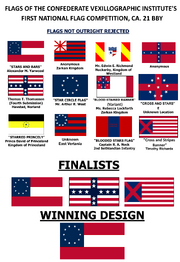
A poster detailing some of the flags submitted to the C.V.I.'s First National Flag competition
The First Convention particularly liked the "Cross and Stripes Banner" submitted by Timothy Richards during the first national flag competition by the C.V.I, this flag featured the "Striped Banner" of East Vertania, at the time still under occupation by then still Union-loyal nation of Kalland, Timothy Richards used East Vertania's stripes as a symbol of the Confederacy's freedom from Union occupation, and expressed a wish that the Confederacy may one day free East Vertania from her occupation, he added a Battle Cross in the canton, which was from a variant of the "Stainless Banner", designed by Jane Zarkan herself, the flag which flew over meeting of the Alliance of Ten's leaders which saw the birth of the Confederate States of Earth, at the time of the selection of the first national flag there were still only 10 nations in the CSE.
In the end, his flag was beaten by the "Stars and Bars", though some in the C.V.I expressed approval of the flag. His flag was in the running to being adopted as the national flag.
"Some in the Institute have expressed their approval of Timothy Richards' "Cross and Stripes Banner", as some have taken to calling it. They particularly enjoyed the inclusion of the Stripes from the as of present imprisoned nation of East Vertania as a representation of our Confederacy's liberty from occupation by the Union. In Timothy Richards' notes, which he sent with a prototype sketch of the flag, he explained that the Stripes have a double meaning, that our Confederacy may one day liberate East Vertania from her occupation.
Also included is a union in the centre of the Hoist, this is rather unusual, since most cantons are placed within the upper Hoist, but it is interesting to say the least. The union consists of a "Battle Cross" battle flag with a red Battle Cross atop a blue field, the canton is reminiscent of Jane Zarkan's Stainless Banner flag, the flag our founders met under to discuss the birth of our free nation, my associates did appreciate this symbolism.
It is the opinion of this institute that Timothy Richards' flag be placed for serious consideration, a misgiving, however, must be noted, that of the recollection of the flag to that of the old Union we liberated ourselves from, whilst the recollection is vague at best, the Union's flag possessing vertical, blue stripes instead of horizontal, red ones, the institute does recommend continuing our search for a national flag, one which has less resemblance to the banner of the Union we removed ourselves from.
-an excerpt from a report by the C.V.I. to the Confederate Parliament, describing Timothy Richards' flag
The First Convention selected Alexander Martin Yarwood's flag as the winner, Alexander's flag featured three horizontal bars, red, white and red, which was based the field of the flag of the State of Lower Etora, the flag from which Yarwood drew the most inspiration. Alexander also drew inspiration from the flag of the West Aerman Confederation.
At the top of the hoist was a blue canton which extended two-thirds of the flag vertically, and about a third of the flag horizontally, within the canton were 10 white stars in a circle (though variants had the stars laid out 9 in the circle and 1 in the middle, as well as in rows or columns), which represented the founding 10 nations of the Confederacy. The flag was officially named the "First National Flag of the Confederate States of Earth", but was most commonly known as the "Stars and Bars". The canton was very similar to the Lower Etora flag's canton.
The First National Flag Act made official the choice of the "Stars and Bars" as the first national flag. The content of the act gave a description of a regulation "Stars and Bars" flag.
The Parliament of the Confederate States of Earth do enact-
That the national flag of the Confederate States of Earth shall consist of a red field with a white stripe extending horizontally through the centre of the red field, and equal in width to one-third the width of the flag. The red stripes thus created above and below the white shall be of equal width as the white stripe. The union blue shall be found within the upper portion of the hoist, extending two-thirds of the flag vertically, through the white stripe and stopping at the lower red one, whilst the union shall extend one-third of the flag horizontally. In the centre of the union there shall be a circle or constellation of white stars corresponding in their number to that of the number of nations within these Confederate States.
—Part of the First National Flag Act, the act then goes on to give specific dimensions for a regulation flag
Despite the act creating the "Regulation Flag", as flags produced to the act's specifications were known, there was a wide variety of different designs, some had the canton in different places, even removed entirely, some had different width stripes, some had the stars arranged in different layouts, some seemingly of random.
The very first "Stars and Bars" flag was raised above the Confederate Parliament on the very same day as the passing of the act, to much cheer and a military band playing the "Starred Banner March", a naval march composed by Admiral Albert George Kail, the crowd immediately fell in love with the flag design.
Never has God's cool breeze ever kissed a banner so majestic, wondrous and awe-inspiring as that of our First National Flag!
—A member of the crowd who witnessed the raising of the very first "Stars and Bars" flag, during the flag's raising
Alexander's flag proved so immensely popular with the nation that during the Second and Third Conventions the C.V.I. originally had planned remove any similarity with that of the Union from the flag, but the flag had become so ingrained in the Confederate national consciousness and popular culture the Committee found themselves being unable to remove the "Bars", they were even unable to adopt different coloured "Bars", the red-white-red "Bars" stayed on both the Second and Third national flags. His flag was widely considered worldwide to be one of the most beautiful flag designs ever created.
Gallery of Confederate flags[]
Appearances[]
- Ashes of War (First non-canon appearence)
- A.R.K.: Ancients to the Modern Aliens (Chronologically first non-canon appearance)
Behind the Scenes[]
- The concept of "Imperialism" is inspired by "Manifest Destiny" and the real-world concept of "New Imperialism", in particular the concept of the "Civilising mission". The "Western Fertilisation" policy is partially inspired by the concept of "Lebensraum" and related practices of Settler colonialism, but is also once again inspired by "Manifest Destiny".

